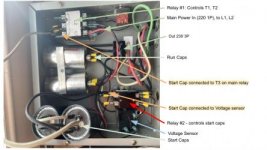I recently sold my old shop, stripped out everything and moved into my new garage. Unfortunately, I was very short on time while packing up the old shop and I didn't document things as well as I should have. Nor apparently pack them well
Its a WNY panel, version RP10.
So 10 hp planel, 230 v with a 5 hp idler, servicing a 5 hp lathe motor. \\
(I previously had a 10 hp idler on there, but thats all still in storage)
There were 4 caps:
- 2 black - Packard PRMJ270 start caps, 330 vac, 270-324 MFD
- 2 silver - I can't read the specs but assume they are the run caps
Last weekend I tried to install and hook up the RPC. But:
- the idler motor won't spin up to speed.
Its a 5 hp motor, thats blowing a 30 amp circuit, with no load.
(I checked the motor and its set for 230v not 460)
The start caps came loose, so did the wires. So I don't know how to hoop it back up.
This is my current state.

I've not been able to find a wiring diagram for this.
I doubt anything is wrong with the unit, I likely just need to know how to wire up the start caps.
Any and all help is much appreciated!
Olaf
Its a WNY panel, version RP10.
So 10 hp planel, 230 v with a 5 hp idler, servicing a 5 hp lathe motor. \\
(I previously had a 10 hp idler on there, but thats all still in storage)
There were 4 caps:
- 2 black - Packard PRMJ270 start caps, 330 vac, 270-324 MFD
- 2 silver - I can't read the specs but assume they are the run caps
Last weekend I tried to install and hook up the RPC. But:
- the idler motor won't spin up to speed.
Its a 5 hp motor, thats blowing a 30 amp circuit, with no load.
(I checked the motor and its set for 230v not 460)
The start caps came loose, so did the wires. So I don't know how to hoop it back up.
This is my current state.

I've not been able to find a wiring diagram for this.
I doubt anything is wrong with the unit, I likely just need to know how to wire up the start caps.
Any and all help is much appreciated!
Olaf


